State of Our Schools – Mitchell Elementary School
The first of many posts providing first-hand accounts of actual public school conditions in Philadelphia and some other areas around the country. The situations described will present a detailed and “granular” level view of our schools, with a particular focus on examining the impacts of school conditions on the health and safety of our children, adult school occupants, parents and the public. The consequences of deteriorated building conditions and related Indoor Environmental Quality [IEQ] hazards on educational opportunity, academic achievement, fiscal and environmental sustainability, and social justice and equity will also be looked at. Discussion about what can and should be done – practical, implementable, cost-effective, timely and, most of all, necessary – about the deplorable conditions of our schools will be explored.
*************************************************
Kristen Graham’s recent story [2/21] about Mitchell ES provides a great picture of the hard work done by the school principal, staff, students, & parents in making important improvements just during the first 7 months of this school year.
Following up on that story were more distressing stories about Mitchell ES being one of 4 schools to “begin academic turnarounds in the fall at 4 Philadelphia Elementary Schools with low test scores” and also about a Town Hall meeting held on Monday 3/7/2016 .
The common thread running through these pieces is about an SDP and SRC leadership making massive staff and organizational changes at schools, including Mitchell, as part of their effort to “improve them” instead of taking responsibility for the years of facility/building neglect and the failures to effectively respond to many of the problems. At Mitchell, a story of an energetic, caring and capable principal, an involved staff described by the school principal as “soldiers for this work. I saw how hard they worked, despite the way things were crumbling around them. They could all go to other schools, but they choose to be at Mitchell” seems to count for very little.
My part in all of this, and the perspective from which I will be writing, is a small and somewhat narrow one. As the Acting Director for Environmental Science & Occupational Safety & Health for the PFTH&WF/U [a mouthful I know], my job for many years has been to inspect, evaluate and assess school conditions and to provide recommendations to make the buildings safer.
In that role I have seen, first hand, the ways in which the SDP allowed building and environmental conditions at Mitchell to deteriorate, compromising building materials, increasing health and safety hazards to children and staff from mold, lead and asbestos, and exacerbating fiscal, academic and emotional distress among occupants. For this reason, it is hard for me, and I think will also be difficult for others, to understand the motivations and actions of the SDP and SRC for the “turnaround” efforts at Mitchell and other schools .
I have inspected Mitchell ES on multiple occasions between June of 2015 & February of 2016. Those inspections, conducted jointly with the SDP’s Office of Environmental Management Services, have identified and documented more than 100 environmental hazard-deficient building conditions including:
- Insect & rodent infestations and droppings in multiple areas;
- The presence of hundreds of square feet of visible mold growth on ceilings, walls & floors;
- Significantly damaged plaster walls, floors and ceilings – dust is considered to be an asthma trigger;
- Exposures to chipping and peeling lead-based [presumed] paint;
- Damage to asbestos-containing materials;
- Water and steam leaks, moisture, dampness and humidity — also asthma triggers
- Burn hazards posed to young children from unprotected steam radiators [185+ degrees F]
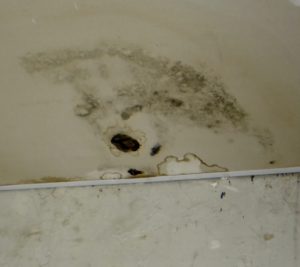
Mitchell ES – Jan., 2016 – Classroom Closet Ceiling – Water Damage/Mold Growth
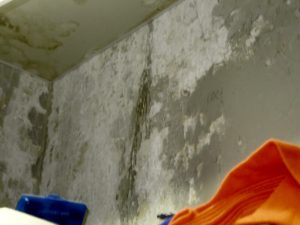
Mitchell ES – Jan., 2016 – Classroom Closet – Damaged Paint [presumed lead] & Plaster
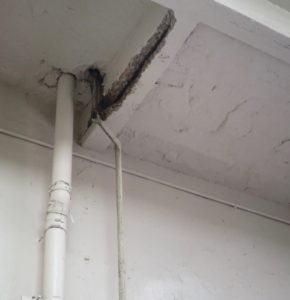
Mitchell ES – Jan., 2016 – Cracked Beam in Bathroom Ceiling
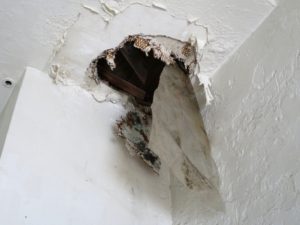
Mitchell ES – Jan., 2016 – Major damage to ceiling paint and plaster
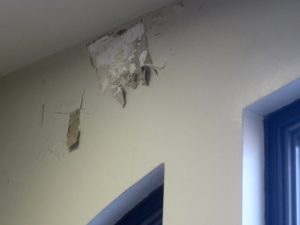
Mitchell ES – Jan., 2016 – Damage to Paint & Plaster in Main Stairwell
Some relevant facts about Mitchell ES related to health and safety issues:
- Mitchell is a K-8 grade school with about 700 students – approximately 95% are African American and 100% are considered “economically disadvantaged” [data from the SDP];
- Based on SDP data and research from the Community Asthma Prevention Program [CAPP] at the Children’s Hospital of Philadelphia [CHOP], about 20% – 40% of students at Mitchell, or about 140-280 students, are expected to have medically diagnosed asthma and/or symptoms consistent with an asthma diagnosis;
- The above statistics are particularly relevant because asthma-related death rates, emergency room visits and hospitalizations are all elevated in the African American population [by a factor of about 3x-5x] compared to white students;
- Asthma results in many days of lost school time/absenteeism – this in turn further undercuts learning and achievement for many; and
- Numerous “asthma triggers” were found to be present at Mitchell ES.
Evaluations of Mitchell ES have provided an “up-close”view of adverse school conditions. Reports & recommendations were issued starting more than 8 months ago, but still, too little progress has been made by the SDP in fixing the identified deficiencies.
With reference to the recent philly.com and notebook.org articles referred to above, at least as applicable to Mitchell ES, is that the physical deterioration at this school didn’t “just happen”; it occurred principally through a long history of neglect, inadequate attention to the presence and impacts of steam leaks, roof leaks, water damage, rotted doors allowing the infiltration of rodents and insects, and a host of other pressing facilities needs. These types of problems, when properly identified, documented and defined, can typically be quickly and cost-effectively fixed. Left alone however, minimized and/or only partially addressed, conditions worsen leading to increasing damage to building and educational materials, the growth of mold, damage to asbestos, and to more costly and time-consuming repairs.
It seems unfair, therefore, for the organization that “created” and allowed many of the building problems we are now seeing to occur and persist, problems now impacting student and staff health, attendance and test scores, to simply throw up their hands and decide that the source of the problems lie elsewhere – not with them – and to ignore some of the incredible work done by the school principal, staff and community. Instead of working with the school administration and staff and with parents and community to do more to fix the problems, it seems as if the SRC and SDP have decided on a course of action that may further destabilize the school without addressing underlying causes.
It should be noted that the remediation actions conducted so far at Mitchell have been a testament to the collaborative efforts, hard work, persistence & involvement of the entire school community, in addition to the organizations representing them. Especially critical has been the help, presence and support of the parents, community members and students themselves, all who have worked tirelessly to improve conditions in the school and to make it their own – a welcoming and high quality educational environment. It was hoped and expected that redoubling efforts could lead to the type of environment that all students and staff have a right to expect and that should be an essential and foundational element in every one of our schools.
The efforts made at the school level needed to be mirrored, and in fact, multiplied, by SDP leadership working in a coordinated and aggressive manner, at the highest level, to quickly improve school conditions in order to establish at least an “adequate” level of safety, health and comfort – unfortunately this has not occurred to the degree required at Mitchell ES.
Stabilization and repair work is urgently needed here. Lead paint, dust and debris from deteriorated plaster, mold growth and rodent and insect infestation pose potentially serious long term health hazards. Children and staff become sick and miss days from school, books and other educational materials are destroyed and unable to be replaced, and the visibly atrocious conditions themselves communicate a sense of uncaring about the school and its occupants, by those in charge, that is corrosive and demoralizing to all.
When confronted with the reality of the school conditions I see and document, conditions based on assessments jointly conducted with SDP environmental representatives on an almost daily basis, teachers, parents, school district administrators, politicians, reporters, and others all are appalled by what they are shown. Comments I hear time and again include, “These conditions are outrageous, no wonder our kids are having such a hard time learning” and “Why won’t anyone fix this?” and “Children shouldn’t be expected to attend schools that look like this,” and “I wouldn’t let my children attend a school that was in this condition.” These statements, always heartfelt and concerned, lead me to question why, then, do our schools continue to look like this and how can SDP managers and others allow these situations to exist? If “we” wouldn’t accept “our” children having to tolerate school conditions like the ones we are talking about, why is it ok to permit other children to be forced to attend such dilapidated buildings?
Mitchell ES is far from a one-off in how it looks and what it needs, and what it needs should have been provided long ago. The fact that so many have been involved at the school over these past 8 months and their efforts have led to such meaningful improvement should provide a great base on which to build.
The necessary actions required to stabilize and fix Mitchell can be achieved in a cost effective and timely way and the PFTH&WF/U has already made initial proposals about how to do so and is in the process of developing a detailed plan. The money we are talking about is on the order of $20 – $40 million and not the $4+ billion figure discussed by the SDP leaders. We believe we can, and must, stabilize and make safe, healthy and comfortable all 200+ Philadelphia school buildings, within a one year period, and for less that 1/100th of the $4+ billion frequently referred to by the SDP.
Fixes such as replacing failing steam traps and installing manual control valves, sealing openings into the building to help minimize rodent and insect infestation, upgrading cleaning efforts, identifying and addressing [at least patch and repair] roof and exterior masonry leaks, scraping and stabilizing deteriorated lead paint and plaster, and ensuring that water damaged building materials are quickly dried and/or removed would make a dramatic difference in the school. Student and staff illness would be reduced, ongoing damage to building materials [walls, ceilings and floors] would be greatly minimized, mold growth and potential exposures to lead and asbestos would be much better controlled and runaway heating significantly reduced. Not only would Mitchell be a much healthier, safer, drier, warmer and more comfortable school but it is likely that many thousands of dollars could be saved in energy costs as well as limiting damage [and necessary replacement] of educational and technology materials as well as walls, ceilings and floors.
Money, personnel, equipment and other resource challenges in the Philadelphia School District are real and financial help is essential . At the same time, we can not allow our children or the staff that teach and support them, to continue to occupy significantly substandard buildings.
I agree with the comments made by Councilwoman Helen Gym at last night’s [Monday, 3/7] City Council Town Hall Meeting at the Sayre HS Library, when she said, “We’re talking about [restoring] the basic tools that schools need to function. We have to pay attention to facilities, we can’t have schools without water access and that are so filthy they make kids feel like their are less than human … students have basic human rights.”
We need to fix our schools and to fix them now — our kids, parents, and school staff deserve it, our city needs it, and social justice, equity and putting our money where our mouths are demands it.
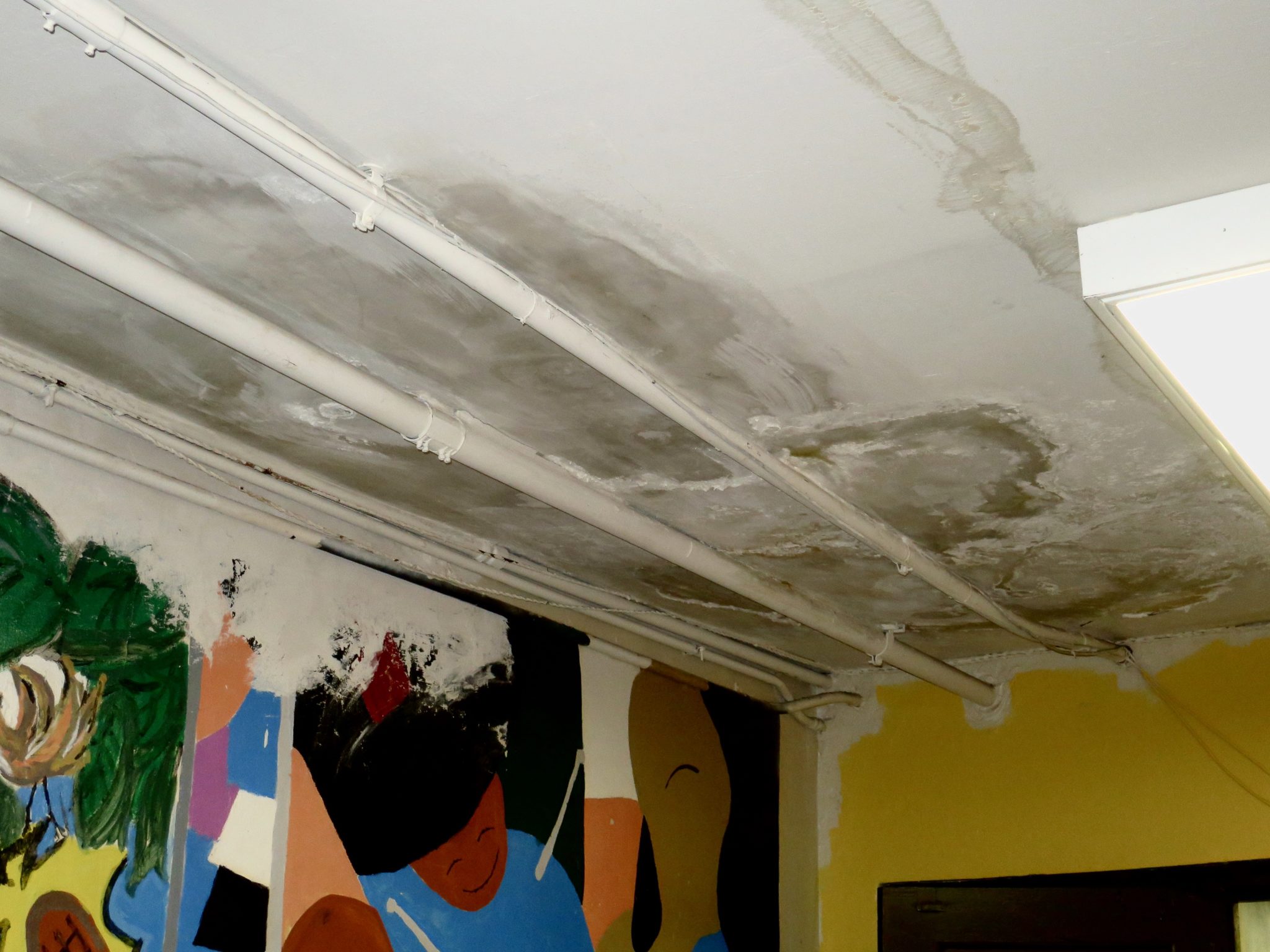
0 Comments on "State of Our Schools – Mitchell Elementary School"